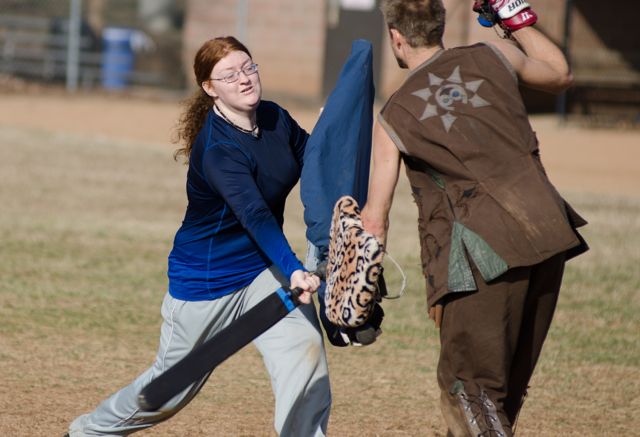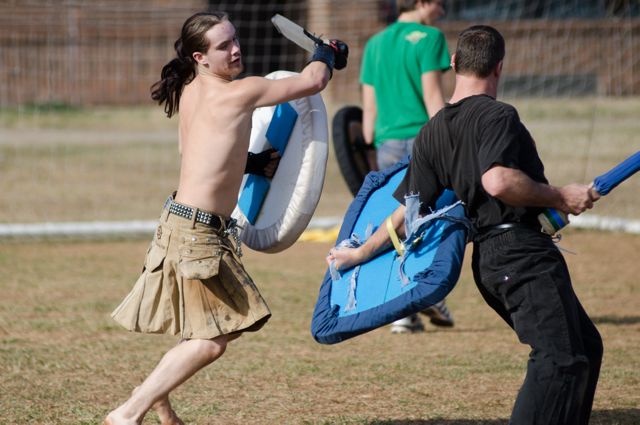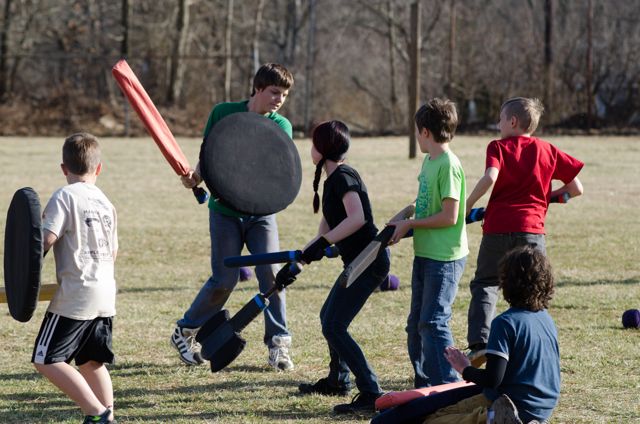Foam-and-pvc swords are the most common weapon, but fighters also use foam glaives, flails, spears, arrows, and axes. And “rocks” (far right) — foam-filled velvet bags that players throw at each other. Photos by Josh Vaugn
Amid snow-capped mountains, in the declining light of a late winter afternoon, warriors line up at one end of a bridge. Armed with rocks, arrows, swords and shields, they hope to deny passage to a superior force approaching from the west. Soon their adversaries arrive, and after several minutes of chaotic battle, a lone, ponytailed archer makes a last stand. Eventually she yields to the inevitable, and it’s over: The invaders have won.
At this point Phil Ferguson, who’s served as coach and referee throughout the fight, calls a halt. Striding forward, the tall, blond, bearded man in medieval garb calls, “Line up! We need to even up these teams.” The warriors — students at ArtSpace Charter School in Swannanoa, where Ferguson’s been teaching a swordplay class this semester — dutifully prepare to put their foam swords, foam-tipped arrows and foam-stuffed “rocks” to use in the next game.
The way Ferguson teaches it, swordplay is a sport with rules borrowed from the Belegarth style of medieval combat. Take a hit on a limb, and you have to give it up — hold your arm behind your back or kneel on your “wounded” leg. Lose two limbs or take a single hit on the torso, and you’re “dead” — either out until the end of the action or required to walk to a specified point to regenerate, depending on the game.

Phil Ferguson, right, spars with Michala Watson. “You become part of a group that has all kinds of mentorship and role modeling going on,” says Ferguson. “And that’s what gets people really hooked on it.”
It’s up to the person receiving a hit to make the call, and it’s a challenge for kids to do that in the heat of battle. This may be why Ferguson is apparently alone among the country’s medieval fighting enthusiasts in focusing so intensively on kids. But for him, and for many parents, it’s a wonderful opportunity to teach sportsmanship — or, as Ferguson describes it, warriors’ honor.
“It’s really about that individual taking responsibility and telling the truth,” says Craig White, who comes to the Sunday battles with his son Xander. The event is sponsored by the Asheville Medieval Collective, which coalesced around Ferguson’s work. “That kind of honor and respect for yourself and others is a great thing to be teaching young people,” says White.
It doesn’t end with honor, however. Ferguson also sees both his classes and the Sunday battles as places where kids and adults alike can learn resilience, teamwork and strategy. What’s more, he says, the variety of roles available gives everyone a chance to learn how to make the most of their unique abilities and attributes.
“It’s great for people of all different kinds of builds,” he says. “It’s inherently set up so you can be really effective and capable in the game, even if you’re not the best fighter, because you get to work with your team.”

Tristan Gunn and Ray Mann, members of the Asheville Medieval Collective, make their own weapons and shields, and dress at Sunday battles ranges from full-on medieval to jeans and T-shirts.
That teamwork builds community, participants say, and it’s at the Sunday gatherings — now back at Carrier Park, after Vance Elementary hosted them over the winter — where that underlying sense of connection is most on display.
“I think that’s the strangest part,” says Charlotte Taylor, who makes the trip from Flat Rock every weekend to take part in the adult battles and train with other members. “We come out here and we hit each other and fight, but really it’s more about building friends.”
Most of these Sunday warriors have made at least some of their own equipment, and people wear various kinds of period garb. Women sport skirts that enable them to fight on equal terms; some men show up in chain mail and kilts, and a few take the field in outfits blending medieval concepts with a punk aesthetic. This is all in keeping with the sport’s DIY, crafty side. Members say they’d like to see more of that, bringing the Asheville Medieval Collective more clearly into the constellation of craft and amateur performing groups that are so prominent in local culture.
For now, though, the collective mostly focuses on fighting, and that’s fine with Ferguson. The foam-buffered kind they practice, he says, provides a safe outlet for the Darwinian survival impulse that underlies most sports, but the direct experience of combat also teaches an important lesson. “You get into a fight with foam swords and one of you lives, but you have an arm or a leg cut off. You’re not just going to beat your opponent, which I think has a lot to teach people about warfare and actual fights. There’s no reason to do it in real life, because you’re going to get hurt.”
For more information about Phil Ferguson and the Asheville Medieval Collective, visit ashevillemedievalcollective.freeforums.org.




Before you comment
The comments section is here to provide a platform for civil dialogue on the issues we face together as a local community. Xpress is committed to offering this platform for all voices, but when the tone of the discussion gets nasty or strays off topic, we believe many people choose not to participate. Xpress editors are determined to moderate comments to ensure a constructive interchange is maintained. All comments judged not to be in keeping with the spirit of civil discourse will be removed and repeat violators will be banned. See here for our terms of service. Thank you for being part of this effort to promote respectful discussion.